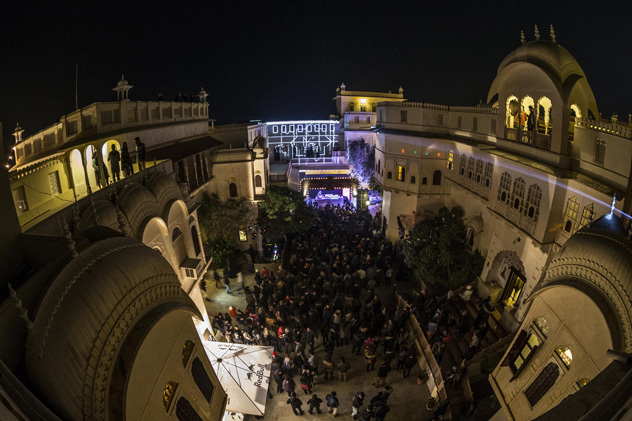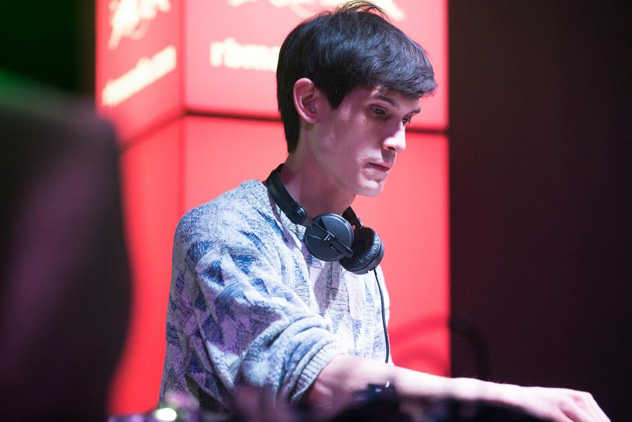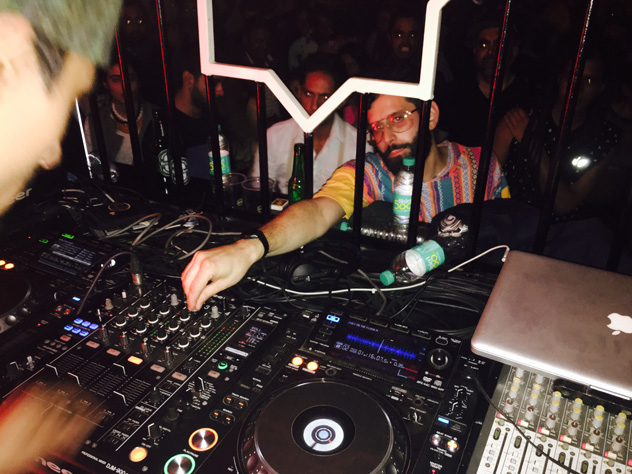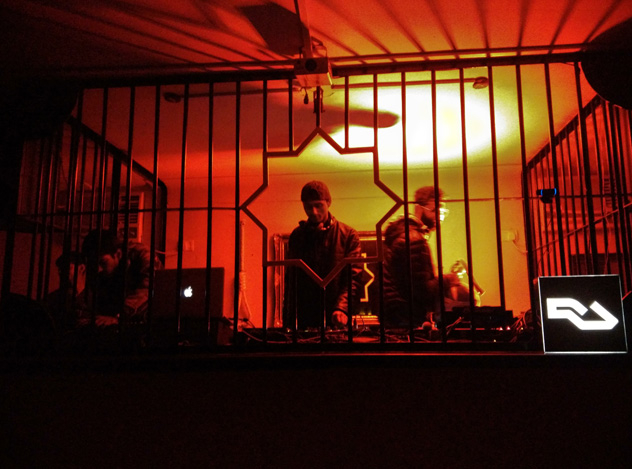- On Friday, December 18th, a few dozen cars converged on a narrow dirt road in Alsisar, a small town in a remote corner of Rajasthan. Horns beeped and traffic marshals whistled as the dusty convoy inched towards its destination: Magnetic Fields. Once the cars reached the festival's drop-off point, attendees wheeled their belongings up a sandy slope to the camping area, a sprawl of Bedouin-style tents equipped with lanterns and deck chairs, while locals, some of whom had set up stalls selling crisps and tea, looked on.
Getting to Magnetic Fields is an adventure. The festival's home is Alsisar Mahal, a 17th century palace turned shabby-chic hotel. Most attendees, whether they started their journey in Europe, India or elsewhere in Asia, made their way to Alsisar via Delhi. My own journey was a bumpy five-hour nighttime drive from Delhi through rural Rajasthan, during which polluted highways gave way to darkened villages where small groups of people huddled around roadside fires.
Since Magnetic Fields started three years ago, its contingent of international artists has swollen considerably, though organisers still focus on regional DJs and live acts. (Artists from India, Pakistan, Malaysia, UAE and Israel all performed in 2015.) For a Western traveller, some of the most remarkable sounds could be heard outside the festival grounds: on two occasions I stumbled across Alsisar locals performing late-night ceremonies—likely an aarti prayer service—with beautiful, stomping music made from chimes and a homemade drum machine.
 But the real star of Magnetic Fields is the palace, Alsisar Mahal. Guests are free to explore pretty much every inch of this wonderful venue. Its rooftops offer views of Alsisar town and the arid landscape beyond, and there are secluded courtyards, grass areas, a pool and all kinds of historical bits—maps, photos, paintings—nearby. Lots of festivals go to great lengths to create an illusion of opulence or fantasy. At Magnetic Fields there's no need for illusion.
On the festival's first afternoon I visited the Desert Disco, a daytime open-air stage in the sandy expanse just outside the palace walls, to find Dubai's The 264 Cru playing records. Their set included some nice disco and soul, but the best moments came when they dropped Eastern-tinged tunes from the likes of Ahmed Abdul-Malik and 47Soul. As the evening crept in, the temperature dropped and people began warming themselves by the log fires that were set up around the festival grounds.
But the real star of Magnetic Fields is the palace, Alsisar Mahal. Guests are free to explore pretty much every inch of this wonderful venue. Its rooftops offer views of Alsisar town and the arid landscape beyond, and there are secluded courtyards, grass areas, a pool and all kinds of historical bits—maps, photos, paintings—nearby. Lots of festivals go to great lengths to create an illusion of opulence or fantasy. At Magnetic Fields there's no need for illusion.
On the festival's first afternoon I visited the Desert Disco, a daytime open-air stage in the sandy expanse just outside the palace walls, to find Dubai's The 264 Cru playing records. Their set included some nice disco and soul, but the best moments came when they dropped Eastern-tinged tunes from the likes of Ahmed Abdul-Malik and 47Soul. As the evening crept in, the temperature dropped and people began warming themselves by the log fires that were set up around the festival grounds.
 After the music finished at the Desert Disco, the festival moved en masse to the palace's South Stage. (There was only ever one stage open at a time, which ensured good crowds at every performance.) Though this stage was musically hit-and-miss across the duration of Magnetic Fields, it showcased a wide range of regional live acts alongside international guests like Shigeto (a standout) and RATATAT.
Later that night on the Red Bull Music Academy North Stage, Palms Trax weaved together a solid selection of house, setting the tone for Hunee and Antal, whose back-to-back session was the festival's highlight. The two work brilliantly together: Antal has a knack for pulling out obscenely good Latin records, while Hunee always has a joyous disco number up his sleeve. After Hunee and Antal, two DJs from Pakistan—TMPST and Rudoh, plus _RHL from Bangalore, India—soundtracked the sunrise by the pool with a mix of footwork and Rustie-style maximalism. Booking Pakistani artists for an Indian festival is not without its problems—the DJs had to check into a police station every morning as part of their entry requirements—but their presence shone light on the kind of small, passionate music scenes that exist in cities like Karachi.
After the music finished at the Desert Disco, the festival moved en masse to the palace's South Stage. (There was only ever one stage open at a time, which ensured good crowds at every performance.) Though this stage was musically hit-and-miss across the duration of Magnetic Fields, it showcased a wide range of regional live acts alongside international guests like Shigeto (a standout) and RATATAT.
Later that night on the Red Bull Music Academy North Stage, Palms Trax weaved together a solid selection of house, setting the tone for Hunee and Antal, whose back-to-back session was the festival's highlight. The two work brilliantly together: Antal has a knack for pulling out obscenely good Latin records, while Hunee always has a joyous disco number up his sleeve. After Hunee and Antal, two DJs from Pakistan—TMPST and Rudoh, plus _RHL from Bangalore, India—soundtracked the sunrise by the pool with a mix of footwork and Rustie-style maximalism. Booking Pakistani artists for an Indian festival is not without its problems—the DJs had to check into a police station every morning as part of their entry requirements—but their presence shone light on the kind of small, passionate music scenes that exist in cities like Karachi.
 On the second night, Mumdance had the North Stage jumping, opening with Lee Gamble's "Rufige" before throwing down a set with just the right mixture of colour and grit. Objekt played with his usual precision, dropping tracks like Powell's "Insomniac" and the Sleeparchive remix of Rhythm & Sound's "Dem Never Know" while psychedelic visuals lit up the palace walls. DJ Koze eased into his session with Four Tet's "Morning Side," which samples famous Indian singer Lata Mangeshkar, before working his way through his trusty repertoire of minimal and tech house tunes.
On the second night, Mumdance had the North Stage jumping, opening with Lee Gamble's "Rufige" before throwing down a set with just the right mixture of colour and grit. Objekt played with his usual precision, dropping tracks like Powell's "Insomniac" and the Sleeparchive remix of Rhythm & Sound's "Dem Never Know" while psychedelic visuals lit up the palace walls. DJ Koze eased into his session with Four Tet's "Morning Side," which samples famous Indian singer Lata Mangeshkar, before working his way through his trusty repertoire of minimal and tech house tunes.
 Later that night the festival moved down to the palace's dungeon for an afterparty headlined by Soul Clap. Like all dungeons, it has a grisly history—"that's the room where they used to hang people," I heard a couple of people say, pointing to a small space where people sat drinking beers and chatting—but it has been refurbished so thoroughly that it actually feels more like a dungeon-themed bar than the real thing. Still, it was a great spot for an afterparty and Soul Clap kept the crowd dancing until sunrise. Those unable to get into the dungeon, including a man dressed in a chicken suit, danced in an outdoor courtyard as the sun rose over the desert.
Later that night the festival moved down to the palace's dungeon for an afterparty headlined by Soul Clap. Like all dungeons, it has a grisly history—"that's the room where they used to hang people," I heard a couple of people say, pointing to a small space where people sat drinking beers and chatting—but it has been refurbished so thoroughly that it actually feels more like a dungeon-themed bar than the real thing. Still, it was a great spot for an afterparty and Soul Clap kept the crowd dancing until sunrise. Those unable to get into the dungeon, including a man dressed in a chicken suit, danced in an outdoor courtyard as the sun rose over the desert.
 The crowd felt a bit more subdued as the third and final night began. Mumbai act Perfect Timing worked an impressively weird cover of "Hotline Bling" into their live show, before Kutmah gave everyone the jolt of energy they needed with a party-rocking selection of classic hip-hop and other curveballs. I left the festival to get a car back to Delhi at about 4:30 AM, and as I walked through the Alsisar town I heard some locals fire up their drum machine and chimes for an aarti. At the same time I could hear the final set of Magnetic Fields echoing down the street. The sounds mingled together happily.
The crowd felt a bit more subdued as the third and final night began. Mumbai act Perfect Timing worked an impressively weird cover of "Hotline Bling" into their live show, before Kutmah gave everyone the jolt of energy they needed with a party-rocking selection of classic hip-hop and other curveballs. I left the festival to get a car back to Delhi at about 4:30 AM, and as I walked through the Alsisar town I heard some locals fire up their drum machine and chimes for an aarti. At the same time I could hear the final set of Magnetic Fields echoing down the street. The sounds mingled together happily.
 Photo credits: Alsisar Mahal: Neville Sukhia. Dungeon: Magnetic Fields team. All others: Artfotos
Photo credits: Alsisar Mahal: Neville Sukhia. Dungeon: Magnetic Fields team. All others: Artfotos
 But the real star of Magnetic Fields is the palace, Alsisar Mahal. Guests are free to explore pretty much every inch of this wonderful venue. Its rooftops offer views of Alsisar town and the arid landscape beyond, and there are secluded courtyards, grass areas, a pool and all kinds of historical bits—maps, photos, paintings—nearby. Lots of festivals go to great lengths to create an illusion of opulence or fantasy. At Magnetic Fields there's no need for illusion.
On the festival's first afternoon I visited the Desert Disco, a daytime open-air stage in the sandy expanse just outside the palace walls, to find Dubai's The 264 Cru playing records. Their set included some nice disco and soul, but the best moments came when they dropped Eastern-tinged tunes from the likes of Ahmed Abdul-Malik and 47Soul. As the evening crept in, the temperature dropped and people began warming themselves by the log fires that were set up around the festival grounds.
But the real star of Magnetic Fields is the palace, Alsisar Mahal. Guests are free to explore pretty much every inch of this wonderful venue. Its rooftops offer views of Alsisar town and the arid landscape beyond, and there are secluded courtyards, grass areas, a pool and all kinds of historical bits—maps, photos, paintings—nearby. Lots of festivals go to great lengths to create an illusion of opulence or fantasy. At Magnetic Fields there's no need for illusion.
On the festival's first afternoon I visited the Desert Disco, a daytime open-air stage in the sandy expanse just outside the palace walls, to find Dubai's The 264 Cru playing records. Their set included some nice disco and soul, but the best moments came when they dropped Eastern-tinged tunes from the likes of Ahmed Abdul-Malik and 47Soul. As the evening crept in, the temperature dropped and people began warming themselves by the log fires that were set up around the festival grounds.
 After the music finished at the Desert Disco, the festival moved en masse to the palace's South Stage. (There was only ever one stage open at a time, which ensured good crowds at every performance.) Though this stage was musically hit-and-miss across the duration of Magnetic Fields, it showcased a wide range of regional live acts alongside international guests like Shigeto (a standout) and RATATAT.
Later that night on the Red Bull Music Academy North Stage, Palms Trax weaved together a solid selection of house, setting the tone for Hunee and Antal, whose back-to-back session was the festival's highlight. The two work brilliantly together: Antal has a knack for pulling out obscenely good Latin records, while Hunee always has a joyous disco number up his sleeve. After Hunee and Antal, two DJs from Pakistan—TMPST and Rudoh, plus _RHL from Bangalore, India—soundtracked the sunrise by the pool with a mix of footwork and Rustie-style maximalism. Booking Pakistani artists for an Indian festival is not without its problems—the DJs had to check into a police station every morning as part of their entry requirements—but their presence shone light on the kind of small, passionate music scenes that exist in cities like Karachi.
After the music finished at the Desert Disco, the festival moved en masse to the palace's South Stage. (There was only ever one stage open at a time, which ensured good crowds at every performance.) Though this stage was musically hit-and-miss across the duration of Magnetic Fields, it showcased a wide range of regional live acts alongside international guests like Shigeto (a standout) and RATATAT.
Later that night on the Red Bull Music Academy North Stage, Palms Trax weaved together a solid selection of house, setting the tone for Hunee and Antal, whose back-to-back session was the festival's highlight. The two work brilliantly together: Antal has a knack for pulling out obscenely good Latin records, while Hunee always has a joyous disco number up his sleeve. After Hunee and Antal, two DJs from Pakistan—TMPST and Rudoh, plus _RHL from Bangalore, India—soundtracked the sunrise by the pool with a mix of footwork and Rustie-style maximalism. Booking Pakistani artists for an Indian festival is not without its problems—the DJs had to check into a police station every morning as part of their entry requirements—but their presence shone light on the kind of small, passionate music scenes that exist in cities like Karachi.
 On the second night, Mumdance had the North Stage jumping, opening with Lee Gamble's "Rufige" before throwing down a set with just the right mixture of colour and grit. Objekt played with his usual precision, dropping tracks like Powell's "Insomniac" and the Sleeparchive remix of Rhythm & Sound's "Dem Never Know" while psychedelic visuals lit up the palace walls. DJ Koze eased into his session with Four Tet's "Morning Side," which samples famous Indian singer Lata Mangeshkar, before working his way through his trusty repertoire of minimal and tech house tunes.
On the second night, Mumdance had the North Stage jumping, opening with Lee Gamble's "Rufige" before throwing down a set with just the right mixture of colour and grit. Objekt played with his usual precision, dropping tracks like Powell's "Insomniac" and the Sleeparchive remix of Rhythm & Sound's "Dem Never Know" while psychedelic visuals lit up the palace walls. DJ Koze eased into his session with Four Tet's "Morning Side," which samples famous Indian singer Lata Mangeshkar, before working his way through his trusty repertoire of minimal and tech house tunes.
 Later that night the festival moved down to the palace's dungeon for an afterparty headlined by Soul Clap. Like all dungeons, it has a grisly history—"that's the room where they used to hang people," I heard a couple of people say, pointing to a small space where people sat drinking beers and chatting—but it has been refurbished so thoroughly that it actually feels more like a dungeon-themed bar than the real thing. Still, it was a great spot for an afterparty and Soul Clap kept the crowd dancing until sunrise. Those unable to get into the dungeon, including a man dressed in a chicken suit, danced in an outdoor courtyard as the sun rose over the desert.
Later that night the festival moved down to the palace's dungeon for an afterparty headlined by Soul Clap. Like all dungeons, it has a grisly history—"that's the room where they used to hang people," I heard a couple of people say, pointing to a small space where people sat drinking beers and chatting—but it has been refurbished so thoroughly that it actually feels more like a dungeon-themed bar than the real thing. Still, it was a great spot for an afterparty and Soul Clap kept the crowd dancing until sunrise. Those unable to get into the dungeon, including a man dressed in a chicken suit, danced in an outdoor courtyard as the sun rose over the desert.
 The crowd felt a bit more subdued as the third and final night began. Mumbai act Perfect Timing worked an impressively weird cover of "Hotline Bling" into their live show, before Kutmah gave everyone the jolt of energy they needed with a party-rocking selection of classic hip-hop and other curveballs. I left the festival to get a car back to Delhi at about 4:30 AM, and as I walked through the Alsisar town I heard some locals fire up their drum machine and chimes for an aarti. At the same time I could hear the final set of Magnetic Fields echoing down the street. The sounds mingled together happily.
The crowd felt a bit more subdued as the third and final night began. Mumbai act Perfect Timing worked an impressively weird cover of "Hotline Bling" into their live show, before Kutmah gave everyone the jolt of energy they needed with a party-rocking selection of classic hip-hop and other curveballs. I left the festival to get a car back to Delhi at about 4:30 AM, and as I walked through the Alsisar town I heard some locals fire up their drum machine and chimes for an aarti. At the same time I could hear the final set of Magnetic Fields echoing down the street. The sounds mingled together happily.
 Photo credits: Alsisar Mahal: Neville Sukhia. Dungeon: Magnetic Fields team. All others: Artfotos
Photo credits: Alsisar Mahal: Neville Sukhia. Dungeon: Magnetic Fields team. All others: Artfotos